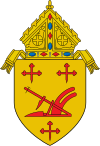| New St. Joseph Cemetery | |
|---|---|
 | |
| Details | |
| Established | 1843/1853 |
| Location | |
| Country | US |
| Type | Private, Roman Catholic |
| Owned by | St. Joseph New Cemetery Association |
| Size | 163 acres (0.66 km2) |
| Website | www |
| Find a Grave | New St. Joseph Cemetery |
New St. Joseph Cemetery is a Catholic cemetery located at West Eighth Street and Nebraska Avenue in Cincinnati, Ohio in the Price Hill neighborhood. The original Old St. Joseph's Cemetery was founded at West Eight Street & Enright Avenue, in 1843 by Rev. John Baptist Purcell, for English speaking Catholics. The new cemetery was created in 1853 following the cholera outbreak which began in 1849, as the Irish section of St. Joseph Cemetery had reached its capacity, the new cemetery was located two miles (3 km) west. The Old St. Joseph's Cemetery, was used mostly by German Catholics.[1]
Originally New St. Joseph's land plot was sixty-one acres, but today the cemetery grounds encompass one-hundred and sixty-three acres, which was once part of the Terry family farm. The grounds are maintained by the St. Joseph Cemetery Association.[2]
The 29 graves of Delphi Universalist Church Cemetery is located on a half acre lot within the bounds of St. Joseph's.
List of notable inurnments[edit]
- Walter Connolly (1887–1940) – American character actor
- William Henry Elder (1819–1904) – Roman Catholic Bishop of Cincinnati
- Henry K. Moeller (1849–1925) – Roman Catholic Bishop of Cincinnati
References[edit]
- ^ Cincinnati Catholic Cemetery Society
- ^ Grace, Kevin; Tom White (2004). Cincinnati Cemeteries: The Queen City Underground. Arcadia Publishing. pp. 46–47. ISBN 0-7385-3348-3.
External links[edit]
- St. Joseph's New Cemetery
- Saint Joseph New Cemetery, a.k.a. New Saint Joseph Cemetery, New Saint Josephs Catholic Cemetery, Saint Josephs New Cemetery at Find a Grave
- U.S. Geological Survey Geographic Names Information System: Saint Josephs Cemetery
- U.S. Geological Survey Geographic Names Information System: Saint Josephs Cemetery



Well, that’s interesting to know that Psilotum nudum are known as whisk ferns. Psilotum nudum is the commoner species of the two. While the P. flaccidum is a rare species and is found in the tropical islands. Both the species are usually epiphytic in habit and grow upon tree ferns. These species may also be terrestrial and grow in humus or in the crevices of the rocks.
View the detailed Guide of Psilotum nudum: Detailed Study Of Psilotum Nudum (Whisk Fern), Classification, Anatomy, Reproduction